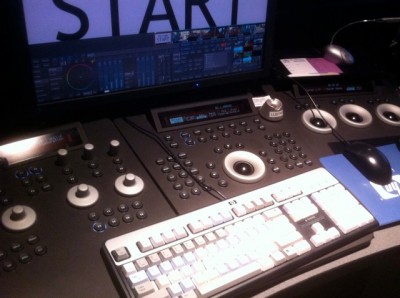 During my recent Resolve 201 class my students and I were lucky enough to get the chance to visit DreamWorks in Los Angeles. Jeff Olm is one of the world’s leading stereo 3D colorists and also a member of the ICA. Jeff has been at the forefront of stereo grading since Journey to the Center of the Earth in 2008. He chatted to us over lunch about his current grading project Madagascar 3 then took us on a tour of DreamWorks ending with a small stereo viewing in his theatre of the Madagascar 3D trailer.
During my recent Resolve 201 class my students and I were lucky enough to get the chance to visit DreamWorks in Los Angeles. Jeff Olm is one of the world’s leading stereo 3D colorists and also a member of the ICA. Jeff has been at the forefront of stereo grading since Journey to the Center of the Earth in 2008. He chatted to us over lunch about his current grading project Madagascar 3 then took us on a tour of DreamWorks ending with a small stereo viewing in his theatre of the Madagascar 3D trailer.
They make animation movies; their titles include Puss in Boots, the Shrek films and Monsters v Aliens to name a but a few. For the past three years everything they have done has been finished in stereo 3D.
What kit do you use?
He uses Autodesk Lustre 2012, with the Lustre panels. In his room he has a projector for grading and a 42″ Plasma, and a large LCD display usd for checking the various deliverables. His room is not large. I imagined he would be sitting in the middle of a huge cinema looking at a 30 metre screen! The finals are all checked in a big theatre but the main percentage of his grading is done in his smaller theatre.
 How long are you on a DreamWorks movie?
How long are you on a DreamWorks movie?
Jeff is on a film for six months, which is much longer than a big live action film which could be three months for a blockbuster.
How many different grading versions do you make?
Each movie has 8 versions including:
- Normal mono
- Stereo 3D
- HD DVD
- Digital Cinema
- Film out including Technicolor Stereo
What version do you start with?
He grades the normal mono pass first then trims this to make all the different stereo versions.
It’s Animation so why does it need grading?
 Jeff explained that he is not doing big changes to the images. The storyboards have been around for a long time so a color change on a key character would be unlikely at the grading stage. He says he approaches it like a live action film, and works on how he can add color and contrast to help add emotion, which subsequently helps tell the story. He also makes little tweeks to balance shots from different VFX artists. When grading animation it is very easy to use external mattes, as every shot of the movie has a matte. This limits the amount of drawing shapes for the colorist.
Jeff explained that he is not doing big changes to the images. The storyboards have been around for a long time so a color change on a key character would be unlikely at the grading stage. He says he approaches it like a live action film, and works on how he can add color and contrast to help add emotion, which subsequently helps tell the story. He also makes little tweeks to balance shots from different VFX artists. When grading animation it is very easy to use external mattes, as every shot of the movie has a matte. This limits the amount of drawing shapes for the colorist.
Who sits with you?
Jeff normally grades in the company of the production designer and the VFX supervisor. The director also supervises the final versions.
DP Roger Deakins worked closely with Jeff on How to Train Your Dragon as a visual consultant.
A huge thanks to Jeff for the DreamWorks tour and an insight into what goes into grading a stereo movie.







